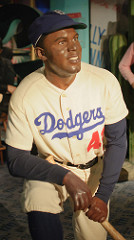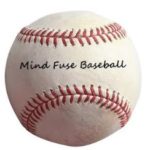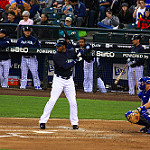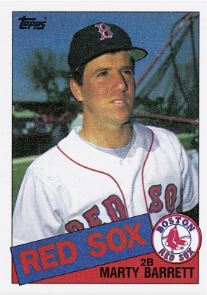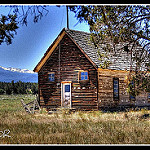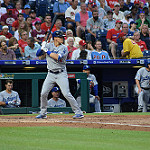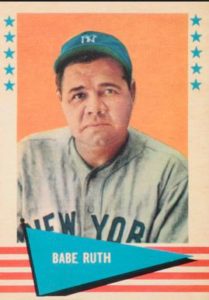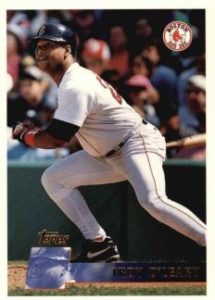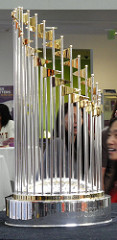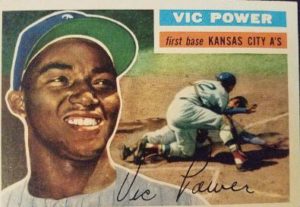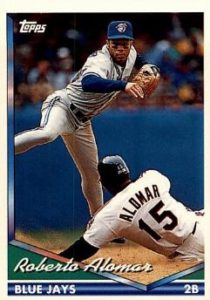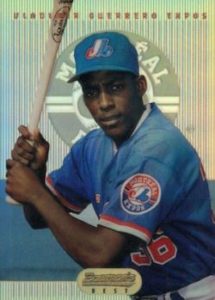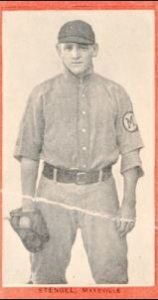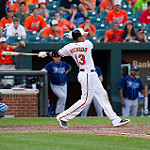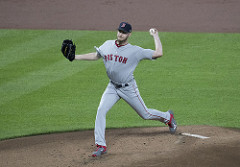New, young talent adds excitement to the natonal pastime and recent years have seen plenty of players making an impact on the diamond. In this post, Baseball Roundtable will present its:
- 2018 Rookie of the Year choices;
- 13-member 2018 All-Rookie Team; and
- All-Time, All-Rookie squad.
For those who like to count such things, the 2018 BBRT All Rookie Team includes eight American Leaguers and five National Leaguers. It also shows considerable diversity with: five players born in the Dominican Republic; four in the United States; two in Venezuala; one in Colombia; and one in Japan.
Let’s start with BBRT’s selections for top rookie in each league.
—–BBRT ROOKIE OF THE YEAR SELECTIONS—–
American League – Shohei Ohtani, Angels (P-DH)
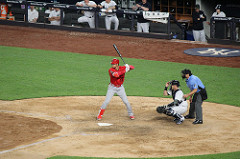
Photo by shinya 
The 24-year-old Shohei Ohtani came to the major leagues – from Japan – with a reputation for having a power arm and a power bat. The 6’4”, 200-pound right-hander pitcher/left-handed batter was a veteran of five seasons in Japan where hit .286-48-166 in 403 games and produced a 42-15, 2.52 record on the mound (624 strikeouts in 543 innings pitched).
Ohtani made his MLB debut on March 29 (Opening Day) as the Angels’ Designated Hitter – collecting a single in his first MLB at bat. (Ultimately, going one-for-five in the Angels’ 6-5 loss to the A’s.) On April 1, he made his MLB pitching debut, going six innings, giving up three runs on three hits, with one walk and six strikeouts – picking up his first major league victory as the Angels topped Oakland 7-4.
In early-June, Ohtani was placed on the Disabled List (elbow) and he returned in early July primarily as a DH. Ohtani pitched just one game after June 6 – taking the in a 2 1/3-inning start (two runs on two hits, with two walks and two whiffs) in a September 2 loss to the Astros. On October 1, Ohtani had Tommy John surgery.
Ohtani finished his rookie campaign hitting .285, with 22 home runs, 61 RBI and ten stolen bases in 104 games. On the mound, he went 4-2, 3.31 in ten starts – fanning 63 batters in 51 2/3 innings. He earns BBRT’s nod as the AL’s top rookie for that versatility and the fact that he did no let pitching-related arm troubles carry over to his performance at the plate.
Coming in a close second – in BBRT’s ranking, was Yankees’ 23-year-old 3B Miguel Andujar, who went .297-25-97 in 149 games and played an integral role in the Yankees’ drive to the post-season.
National League – Ronald Acuna Jr., Braves (OF)
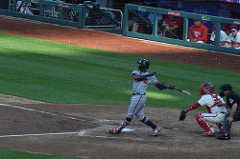
Photo by DandreaPhotography 
The Braves’ have a ton of exciting, young talent – perhaps none more exciting than 20-year-old Venezuelan outfielder Ronald Acuna, Jr. Acuna made his debut on April 25 and took the field in 111 games for Atlanta. The six-foot, 180-pound right-handed hitter put up a stat line of .293-26-64, with 78 runs scored and 16 stolen bases in 21 attempts. In producing those numbers, Acuna notched a number of highlights including becoming just the fourth player to homer to lead off both games of doubleheader and the youngest MLB player to homer in five consecutive games. In the post-season (NLDS), Acuna also became the youngest major leaguer to hit a post-season Grand Slam.
In 259 minor league games (four seasons), Acuna hit .301, with 30 home runs and 122 RBI. In 2017, he played at High A, Double A and Triple A – going a combined .325-21-82 with 44 stolen bases.
Finishing second to Acuna on the BBRT NL Rookie list was the Nationals’ 19-year-old outfielder Juan Soto – who made his MLB debut May 20 and put up a stat line of .292-22-70, with 77 runs scored and five stolen bases in 116 games. The margin of difference was minimal, with BBRT giving Acuna the edge based on his 16 steals.
——————————————————————–
BASEBALL ROUNDTABLE’S 2018 ALL-ROOKIE TEAM
Catcher – Jorge Alfaro, Phillies (Born: Sincelejo, Colombia)
Originally signed by the Rangers, Jorge Alfaro was traded to the Phillies in late July of 2015. In 2016-17, he played in 35 games for the Phillies (retaining his rookie status for 2018) – showing considerable promise (.293-5-14). The 25-year-old opened the 2018 season with the Phillies and put up a solid .262-10-37 stat line in 108 games. In eight minor league seasons, Alfaro hit .270-15-51 in 634 games.
Shades of the Molinas? Jorge Alfaro’s brother – 20-year-old Jhoandro Alfaro – is in his fourth pro season as a catcher in the White Sox’ system.
First Base – Ronald Guzman, Rangers (Born: La Vega, Dominican Republic)
The 23-year-old left-handed hitting Ronald Guzman – at 6′ 5″, 225-pounds – showed good power with 16 home runs and 58 RBI in 123 games (.235 average). Guzman was signed by the Ranger in 2011 and made his pro debut (age 17) in 2012 – hitting .321-1-33 in 52 games at the Rookie-League level. In seven minor league seasons, he hit .275-51—339 in 607 games.
Ronald Guzman’s father Manuel saw Guzman play professional baseball for the first time on August 10, 2018 – as the Rangers took on the Yankees in New York. Guzman rewarded his dad with a three-for-five, three-home run day.
Second Base – Gleyber Torres, Yankees (Born: Caracas, Venezuela)
Tough choice here between the Rays’ Joey Wendle (.300-7-61, 16 steals in 139 games) and Yankees’ Gleyber Torres (.271-24-77, with six steals, in 123 games). BBRT is going with Torres for a handful of reasons: 1) I like his advantage in power; 2) At 21, he is seven years younger than Wendle; and 3) Wendle had already seen MLB action in 2016 and 2017 (a total of 36 games with the A’s).
Torres was originally signed by the Cubs in 2013 and made his pro debut in 2014 at the age of 17 – hitting .297-2-33 at the Rookie- and A-Levels. He was traded to the Yankees in July of 2016 (in the trade that took Aroldis Chapman to the Cubs). In 2018, Torres started 104 games at 2B and 15 at SS.
On September 2, batting ninth, Gleyber Torres hit his 20th home run of the season. That blast was the 265th for the Yankees, breaking the All Time MLB single-season team record. In addition, it was the 20th home run hit from the ninth spot in the New York order – making the Bronx Bombers the first team with at least 20 home runs from each of the nine spots in the batting order. Note: The Yankees ended the season with an MLB-record 267 home runs.
Third Base, Miguel Andujar, Yankees (Born: San Cristobal, Dominican Republic)
Another young Yankee, the 23-year-old Miguel Andujar hit .297-27-92 in 149 games after opening the season with the Yankees on April 1. (He did play five games with New York in 2017.) Andujar was signed by the Yankees in 2011 and made his professional debut (at age 17) at the Rookie-League level in 2012 – going .232-1-19 in 50 games. Again at the Rookie-League level the following season, Andujar showed his promise – going .323-4-25 in 34 games. Over six minor league seasons, he hit .274-51-336 in 596 games.
Miguel Andujar hit 47 doubles in 2018 – the most two-baggers ever by a Yankee rookie. The record (44) had been held by Joe DiMaggio – pretty good company.
SS – Willy Adames, Rays (Born: Santiago, Dominican Republic)
The 23-year-old Willy Adames made his MLB debut on May 22 and went .278-10-34, with six steals, in 85 games for the Rays. He finished the season strong, hitting .329-7-25 in 51 August-September games. Signed by the Tigers in 2012, Adames was traded to the Rays in 2014. In six minor league seasons, Adames hit .270, with 38 home runs, 281 RBI and 52 steals in 617 games.
Willy Adames’ first MLB hit – in his debut game – was a home run off Chris Sale.
OF – Ronald Acuna, Jr. Braves (Born: LaGuaira, Venezuela)
Ronald Acuna, Jr. put up a .293-26-64 line, with 16 steals. (See details in the BBRT Rookie of the Year selections at the top of the post.)
OF – Juan Soto, Nationals (Born: Santo Domingo, Dominican Republic)
Making his MLB debut as a teenager (May 2), the left-handed hitting Juan Soto hit .292, with 22 home runs and 70 RBI in 116 games. The 6’1”, 185-pound outfielder has hit everywhere he’s played. As a 17-year-old (at the Rookie- and Low-A levels), he hit a combined .368-5-32 in 51 games. Over three minor league seasons, Soto raked at a .362 pace, with 22 homers and 102 RBI in 122 games.
In his first MLB start – second MLB game – Juan Soto became the youngest player in the Expos/Nationals franchise history to hit a home run (19 years and 208 days).
OF – Daniel Palka, White Sox (Born: Greenville, South Carolina)
The 26-year-old Daniel Palka appeared in 124 games for the White Sox in 2018 and powered 27 home runs (.240 averages and 67 RBI). Drafted in the third round of the 2013 MLB draft by the Diamondbacks, he was traded to the Twins in 2015 and then selected off waivers by the White Sox in 2017. The 6’2”, 220-pound left-handed hitter showed good power in the minors, topping 20 home runs in 2014-15-16. In six minor league seasons, he hit .270, with 109 home runs, 368 RBI and 48 steals.
Daniel Palka had a powerful final month in 2018 – hitting .250, with eight home runs and 14 RBI in 25 September games.
DH – Shohei Ohtan, Angels (Born: Oshu, Japan)
Shohei Ohtani, the two-way Japanese star, hit .285-22-61 in 104 games – and went 4-2, 3.31 on the mound. (See details in the BBRT Rookie of the Year selections at the top of this post.)
Shohei Ohtani is credited with the fastest pitch ever thrown in Nippon Professional Baseball history – as 102.5 mph.
Utility – Niko Goodrum, Tigers (Born: Fayetteville, Georgia)
Niko Goodrum was signed as a free agent by the Tigers in November 2017. The 26-year-old, 6’3” 198-pound switch hitter made his Tigers’ debut April 1 (but had played 11 games with the Twins in 2017). His line for the season, .245-16-53, with 12 steals.
A true utility player, in 2018, Niko Goodrum started 59 games at 2B, 22 games at 1B, 10 at SS, 10 in LF, 9 at 3B, and 7 in RF.
SP – Walker Buehler, Dodgers (Born: Lexington, Kentucky)
Walker Buehler – a Dodgers’ first-round draft choice in 2015 – made his MLB debut on September 17, 2017. He pitched in eight games for the Dodgers that season and went 1-0, with a 7.71 ERA in 9 1/3 innings. In 2018, still considered a rookie, Buehler lived up to his first-rounder status. The 6’2”, 175-pound right-hander went 8-5, with a tidy 2.62 earned run average and 151 strikeouts (versus just 37 walks) in 137 1/3 innings (23 starts in 24 appearances). The rookie played a key role in the Dodgers’ NL West title drive. In three minor league campaigns, Buehler went 5-3, 3.04 – fanning 152 batters in 109 2/3 inning.
Walker Buehler signed with the Dodgers, as a first-rounder, in July of 2017 – and had Tommy John surgery before making his professional debut just over a year later.
RP – Seranthony Dominguez, Phillies (Born: Esperanza, Dominican Republic)
Seranthony Dominguez appeared in 53 games for the Phillies in his rookie season – picking up 16 saves in 20 opportunities, posting a 2-5 won-lost record and a 2.95 earned run average. On the season, he fanned 74 batters (22 walks) in 58 innings. Signed in 2011, he began his pro career at 17 in the Dominican Summer League (Rookie League) – going 4-4, 3.48.
Dominguez opened the 2018 season with the Double-A Reading Fightin’ Phils (1-2, 2.08), was soon promoted to the Triple-A Lehigh Valley Iron Pigs (1-0, 0.00) and, by May 7, was called up to the Phillies. In seven minor league seasons, Dominguez went 23-22, 3.03 with 299 whiffs in 326 2.3 innings.
In his first six MLB appearances, Seranthony Dominguez did not allow a hit or a walk (6 2/3 innings), while fanning seven. In his first 12 MLB appearances, he allowed just two hits and no walks, while fanning 16 in 14 2/3 innings – maintaining a 0.00 ERA until his 13th MLB game.
“Utility” Pitcher – Ryan Yarborough Rays (Born: Lakeland, Florida)
Okay, the Rays have really pushed the envelope with the “bullpen game” formula for getting outs – which makes the role of Rays’ southpaw rookie Ryan Yarbrough hard to classify. Still, you cannot leave this 23-year-old off the All Rookie squad after a 16-6, 3.91 record in 2018. The 6’5”, 205-pounder stood tall on the mound – tossing 147 1/3 innings in 38 appearances (six starts). BBRT just cannot ignore those 16 wins.
In four minor league seasons, Yarbrough went 29-19, 3.22 – primarily as a starter (87 appearances, 83 starts, one complete game).
Ryan Yarbrough led all rookie pitchers in wins in 2018 – with 16 victories.
————————————————————
BASEBALL ROUNDTABLE’S ALL-TIME ROOKIE TEAM
C – Mike Piazza, Dodgers, 1993 … .318-37-130
Mike Piazza may be the most unlikely member of this All-Time, All-Rookie squad. Piazza was chosen by the Dodgers in 62nd Round of the 1988 MLB draft – meaning that more than 1,300 played were selected before him. Five years later – as a 24-year-old rookie, Piazza was an All Star and the NL Rookie of the Year – hitting .318-35-112. In a total of 16 seasons, Piazza earned his way into the Baseball Hall of Fame – hitting .308, with 427 home runs and 1,335 RBI. He was a 12-time All Star, topped .300 10 times. Hit 30 or more home runs nine times (a high of 40 in 1997 and 1999) and drove in 100 or more runs in six seasons.
Albert Pujols, Cardinals, 2001 … .329-37-130
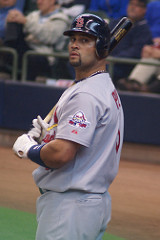
Photo by shgmom56, Barbara Moore 
At the ripe young age of 21, Albert Pujols put up the first in a string of remarkable seasons – earning the 2001 Rookie of the Year Award and a fourth-place finish in the MVP balloting. Pujols hit .329, with 37 home runs, 130 RBI and 112 runs scored. Over the first ten seasons of his career, he topped a .300 average, 30 home runs and 100 RBI every season. At the close of the 2018 season, Pujols was a ten-time All Star, three-time league MVP and two-time Gold Glove winner – boasting a career average of .302, 3,082 base hits, 633 home runs and 1,982 RBI.
Albert Puhjols gets extra credit for versatility. In his rookie season, Pujols started 53 games at 3B; 38 in LF; 33 in RF; 31 at 1B; and 2 at DH.
2B – Harvey Kuenn, Tigers, 1953 …. .308-2-48, with 94 runs scored.
Tough choice here. I really wanted to put in Jackie Robinson (the first-ever Rookie of Rookie of the Year winner – in 1947). Robinson, however, started exclusively at 1B that season. BBRT’s top rookie second-sacker is Harvey Kuenn. As a 22-year-old rookie in 1953, Kuenn was the AL Rookie of the Year – leading the league in plate appearances (731), at bats (679) and, more important for this ranking, base hits (209). Kuenn went on to lead his league in hits four times, won the 1959 batting title (.353) and was an All Star in eight consecutive seasons. He finished his 15-season playing career with a .303 average (nine season at .300 or better) and 2,092 hits, 87 home runs, 671 RBI, 950 runs scored.
3B – Dick Allen, Phillies, 1964 … .318-29-91, with 125 runs scored.
 As a 22-year-old rookie, Dick Allen started 162 games at third base for the Phillies – hitting .318-29-91. He also led the NL in runs scored with 125 total bases with 352 and legged out a league-topping 13 triples. That performance earned him Rookie of the Year honors. Allen went on to become a seven-time All Star, delivering a .292 average, 351 home runs and 1,119 RBI over 15 seasons. He led his league in home runs Twice and RBI once, and was the 1972 AL MVP with the White Sox.
As a 22-year-old rookie, Dick Allen started 162 games at third base for the Phillies – hitting .318-29-91. He also led the NL in runs scored with 125 total bases with 352 and legged out a league-topping 13 triples. That performance earned him Rookie of the Year honors. Allen went on to become a seven-time All Star, delivering a .292 average, 351 home runs and 1,119 RBI over 15 seasons. He led his league in home runs Twice and RBI once, and was the 1972 AL MVP with the White Sox.
SS – Nomar Garciaparra, Red Sox, 1977 … .306-30-98
Nomar Garciaparra’s 1997 rookie campaign was a sign of things to come. The 23-year-old made the All Star and hit .306, with 30 long balls, 98 RBI, 122 runs scored and 22 stolen bases (in 153 games). He led the AL in at bats (684), hits (209), triples (11) and tossed in 44 doubles. Garciaparra went on to play 14 MLB seasons, was a six\-time All Star and was two-time batting champion. He finished with a .313 average, 229 home runs, and 936 RBI.
Shoeless Joe Jackson, Indians, 1911 … .408-7-83

Photo by The Library of Congress
The 23-year-old Indians’ outfielder had been called up for the proverbial MLB “cup of coffee” in 1908, 1909 and 1910, but had seen action in only 30 games – retaining his rookie status. After a 1910 season that saw Jackson hit .354 in 136 games for the Class A New Orleans Pelicans and then .387 in 20 contests for the Indians, Jackson had cemented a spot with the 1911 AL Indians’ squad.
What did he do to earn the top spot on this BBRT list? In 147 games, he hit .408, with 233 hits, 126 runs scored, 45 doubles, 19 triples, seven home runs, 83 RBI and 41 stolen bases. Jackson’s .408 remains the 15th-highest average in any MLB season ever and the sixth-highest since 1900. In 1911, Jackson was second in MLB in batting average (to Ty Cobb’s .420) and one of only two players to hit .400; first in on base percentage (.468); second (to Cobb) in slugging percentage at .590; second in runs scored (again to Cobb); second in hits (Cobb); second in doubles (Cobb); and second in total bases with 337 (Cobb, 367). He finished fourth in the MVP voting.
If it took Ty Cobb in his prime to outhit you in your rookie season, you’ve earned the top spot on this list.
Jackson – caught up in the Black Sox scandal of 1919 – went on to a 13-year career in which he averaged .356, three times led the AL in triples, twice led the AL in hits, twice topped the league in total bases and racked up single seasons leading the AL in doubles, on-base percentage and slugging percentage. By the way, Jackson hit .375 in that infamous 1919 World Series.
Fred Lynn, Red Sox, 1975 … .331-21-105
How can you not have Red Sox flycatcher Fred Lynn near the top of this list? He was the first player to win Rookie of the Year and a Most Valuable Player Award in the same season. It was 1975, but Lynn had shown his promise the season before. Called up from the Triple A Pawtucket Red Sox (where he hit .282-21-68 in 124 games), Lynn closed out the 1974 season hitting .419 in 15 games for Boston. In 1975, he hit .331 (second in the AL), with 21 home runs, 105 RBI and an AL-leading 103 runs scored. – and he won a Gold Glove for his defensive play in center field.
Lynn went on to a 17-season career with a stat line of .283-306-1,111 and four Gold Gloves.
Ted Williams, Red Sox, 1939 … .327-31-145

Photo by Wicker Paradise 
Teddy Ball game broke into the big leagues in 1939 – a 20-year-old rookie. It was his fourth professional season and, in three minor league campaigns, his average had gone from .271 to .291 to .366. In 1939, Williams hit .327, banged out 31 home runs, led all of MLB with 145 RBI and scored 131 times. He finished seventh in the AL in batting average; fifth in hits (185); first in total bases (344); second in doubles (44); fifth in triples (11); and third in home runs (31). The Splendid Splinter finished fourth in the MVP voting in his rookie campaign.
Williams went on to a Hall of Fame career that included: six batting titles; four home run crowns; six seasons leading the league in runs scored; and four seasons at the top of the RBI list. In 19 MLB seasons, Williams also put up an MLB career-best .482 on-base percentage – leading the AL in that category 12 times.
DH – Aaron Judge, 2017 Yankees … .284-52-114
The 25-year-old Aaron Judge blasted an MLB rookie-record 52 home runs in 2017 Despite 208 strikeouts (another rookie record), Judge hit .284, with league-leading 52 home runs, 114 RBI’s and an AL-leading 128 runs. He also topped the league with 127 free passes. Judge, a first–round selection in the 2013 MLB draft (number 32 overall), was selected AL Rookie of the month in April, May, June and September of 2017. In 2018, Judge hit .278-27-67 in 112 games and made his second consecutive All Star squad.
SP – Russ Ford, Yankees, 1910 … 26-6, 1.65
Unlike many of the players on this list, after a spectacular rookie season, right-handed hurler Russ Ford did not go on to a long and illustrious MLB career. Before making the New York Highlanders (Yankees) roster in 1910, Ford did get a somewhat disastrous “cup of major league coffee” in 1909 – one game, three innings pitched, four hits, four walks, three hit batsmen, three earned runs, two strikeouts.
Still a rookie in 1910, the 27-year-old righty went 26-6 with a 1.65 ERA. The 26 wins remains the American League rookie-season record. In his initial full campaign, Ford was second in the AL in wins (26); second in winning percentage (.813); seventh in ERA (1.65); fourth in strikeouts (209); fifth in games started (33); fourth in complete games (29); and second in shutouts (8). On a Highlanders’ team that finished second with an 88-63 record, Ford led the team in virtually every positive pitching category.
Ford followed that rookie season with a 22-11, 2.27 record in 1911, but then led the AL in losses (13-21, 3.55) in 1912 and lost 18 games (versus 12 wins) in 1913. He jumped to Buffalo of the Federal League in 1914, going 21-6, 1.82 … and 5-9, 4.52 in 1915. Historians report that Ford’s career was cut short (he did not pitch in the majors after 1915) with the banning of his signature pitch – the well-scuffed “emery ball.” His final MLB line, over seven seasons, was 99-71, 2.59.
RP – Craig Kimbrel, 2011, Braves … 4-3, 2.10, 46 saves
The 23-year-old Craig Kimbrel was the NL Rookie of the Year in 2011 – after leading the NL in saves (46) and putting up a 4-3, 2.10 record with 127 strikeouts in 77 innings pitched. Now in his ninth season, the elite closer has been all All Star seven times, led his league in saves four times, put up a 1.91 earned run average and fanned 868 batters in 532 2/3 innings.
HONORABLE MENTIONS
Here a few additinal rookie seasons that BBRT finds either remarkable, interesting … or both.
Grover Cleveland Alexander, Phillies, 1911 … 28-13, 2.57
After going a combined 44-19, with a 1.66 ERA in two minor league seasons – D-Level Galesburg Boosters in 1909 and B-Level Syracuse Stars in 1910 (where he went 29-11) – Grover Cleveland “Pete” Alexander made the Phillies’ major league squad in 1911. In his rookie season, Alexander went 28-11, with a 2.57 ERA and finished third in the National League MVP race. (The 28 wins are still the post-1900 record for a rookie.) Here’s what the 24-year-old rookie right-hander accomplished: 28 wins (led NL, tied for MLB lead); 31 complete games (led NL, third in MLB); seven shutouts (led MLB); 227 strikeouts (second in NL, fourth in MLB); 37 games started (second in NL, third in MLB). 6.99 hits per nine innings (lowest in NL, second-lowest in MLB).
Alexander went on to a 20-season Hall of Fame career – 373 wins (208 losses); a 2.56 career ERA; 2,198 strikeouts. He led the NL in wins six times; ERA five times; complete games six times; shutouts 7 times; and strikeouts six times.
Fernando Valenzuela, Dodgers, 1981 … 13-7, 2.48
Fernando Valenzuela went just 13-7 in 1981 – but, remember that was a strike season and no pitcher won more than 14 games. In fact, Valenzuela’s 13-7, 2.48 ERA record earned him Rookie of the Year and Cy Young Award honors, as well as a top-five finish in the MVP voting. The 20-year-old rookie also led the league in starts (25), complete games (11), shutouts (8) innings pitched (192 1/3) and strikeouts (180). Valenzuela went on to a 17-season career (173-153, 3.54).
Mark McGwire, A’s 1987 … .289-49-118
Mark McGwire’s original call up was not an eye-opener (18 games in 1986, with a .189-3-9 stat line.) But he made good on his promise in his first full season – going .289-49-118 for the A’s as a 23-year-old in 1987; and setting a rookie HR record that stood for three decades. McGwire went on to a 16-season MLB career in which he hit .263, with 583 long balls and 1,414 RBI. McGwire led his league in home runs four times (a high of 70 in 1998) and in RBI once (147 in 1999).
Dale Alexander, 1929, Tigers … .343-25-137
Dale Alexander is an “Oh my, what could have been!” story. Alexander broke in at first base with the Tigers in 1929 – after six minor league seasons in which he hit .333 (in 2,924 at bats). The year before he made the Tigers’ squad, Alexander hit .380-31-144 with 15 stolen bases at Toronto of the Double-A International League. As an MLB rookie, Alexander played in all 155 Tigers’ games, hitting .343 (tenth in the league), leading the league with 215 base hits, blasting 25 home runs (fifth in the AL) and driving in 137 runs (third).
A durable player, Alexander again played in every Tigers’ game in 1930, this time hitting .326-20-135. He went on to a .325 average (just three home runs) in 1931 and .367-8-60 (and an AL batting title) in 1932 (a season which included a trade to the Red Sox). Over his first four full seasons, Alexander averaged .338.
In a five-season MLB career – cut short by a truly unexpected injury/health catastrophe – Alexander hit .331, with 61 home runs, 459 RBI and 20 stolen bases.
In May of 1933, Alexander suffered a knee injury and was subjected to a new deep-heat treatment. Unfortunately, Alexander was left in the “diathermy” machine too long and suffered third-degree burns to his leg. Initially, there was concern that he might actually lose the leg, but amputation was avoided. However, the burned and scarred leg did not fully recover, limiting Alexander’s mobility and marking 1933 as his final MLB season. (He did continue to play in the minor until 1942).
Mike Trout, Angels, 2012 … .326-30-83
Mike Trout joined the 30-30 club in his first full MLB season (at the age of 20) – going .326-30-83, with a league-leading 49 stolen bases. He also led the league in runs scored with 149. That performance earned him Rookie of the Year honors and a second-place finish in the AL MVP voting. (Note: Trout hit .220 in a 40-game call up in 2011.)
In his first seven full MLB seasons, Trout has made the All Star team seven times, won two MVPAwards and finished second in MVP voting three times (could be a fourth this year.)
Tony Oliva, Twins 1964 … .323-32-94
25-year-old Tony Oliva won the AL batting crown in his rookie season with .323 average. He also led the AL in hits (217), runs scored (109), doubles (43) and total bases (374). Despite being hampered by knee injuries in the latter part of his career, Tony-O went on to 15 MLB seasons that included three batting crowns, five seasons leading the league in hits and four seasons topping the AL in doubles. Oliva’s career stat line: .304-220-947.
Extra credit to Tony Oliva for following up his rookie batting title by becoming the only player to win a batting title in his first two full seasons (.323 in 1963, .321 in 1964). He also led the league in base hits his first three full seasons
Mark Fidrych, Tigers, 1976 … 1909, 2.34
At 21, Mark “The Bird” Fidrych took baseball – and, in particular, Detroit baseball – by storm. Statically, he went 19-9, with a league-low 2.34 ERA and a league-high 24 complete games. His performance won him Rookie of the Year honors and second place in the Cy Young Award balloting. His 19 wins were third in the AL – keeping in mind that he opened the year in the bullpen and didn’t get his first start until May 15. He went on to throw complete games in his 11 of his first 12 starts.
Fidrych makes this list as much for his antics on the mound – and popularity with the fans – as for his stellar rookie numbers. How can you not recognize a season in which a team draws more than twice as many fans at home for a specific pitcher’s starts? In 1976, the Tigers’ average home attendance on a non-Fidrych start days was 13,843; while the team averaged 33,649 when The Bird started on the Detroit home mound.
In Spring Training 1977, Fidrych injured his knee, but recovered and got off to a good start that season. Going into July, Fidrych was 6-2, with a 1.83 ERA and seven complete games in eight starts. Then, in a July 4 start against the Orioles, he felt something wrong in that valuable right wing (giving up six runs in 5 2/3 innings). He tried a couple more outings (a total of seven runs in 6 1/3 innings) before shutting down. He really never was the same again – eventually having shoulder surgery – and won only four more MLB games after July 1977. Some think the knee injury may have led him to alter his delivery, while others point to the workload of all those complete games. Either way, like Dale Alexander’s, this is an “Oh my, what might have been!” kind of story. The Bird’s final stat line: 29-19, 3.10.
Ichiro Suzuki, Mariners, 2001 … .350-8-69
Okay, I know Ichiro Suzuki should probably be in the All-time, Rookie Lineup – probably right up there around Ted Williams and Fred Lynn. After all, as a 27-year-old MLB rookie, he led the AL with a .350 average and 242 hits – and added a league-leading 56 stolen bases and a Gold Glove. It’s just that those nine seasons in Japan (.353 average and seven batting championships) make it hard from me to figure out where to place him with more traditional rookies.
Still, like Elvis, Cher and Madonna, Ichiro is a star that needs only one name. After a spectacular rookie season in MLB, Ichiro just kept on hitting. He amassed 200+ hits in each of his first ten MLB seasons, leading the league in safeties seven times – and picked up a pair of batting titles along the way. He was also a Gold Glover in each of his first ten seasons. After 18 MLB seasons, Ichiro has a .311 MLB average, 3,089 hits, 117 home runs, 780 RBI, 1,420 runs scored. And let’s not forget those 1,278 hits in Japan. The man has been a hitting machine – and earns special recognition for a spectacular MLB rookie season.
BEST FOR LAST – MLB’s FIRST AND MOST IMPACTFUL ROOKIE OF THE YEAR
Photo by InSapphoWeTrust
In 1947, Major League Baseball honored it first-ever Rookie of the Year – Dodgers’ first baseman Jackie Robinson. (There was initially just on ROY each season.) Robinson’s season may not have been the most spectacular in terms of numbers – .297 average, 12 home runs, 48 RBI, 125 runs (second in the league) and a league-leading 29 stolen bases – but it was extremely significant in terms of the Brooklyn rookie’s impact on the national pastime. In breaking baseball’s “color line,” the 28-year-old Robinson ushered in a new era and, as noted, turned in solid rookie-season performance, despite the many race-related challenges he faced.
Robinson faced those challenges with dignity and a balance of fire and restraint. He went on to a ten-year career MLB that included six All Star selections, a batting title (.342 in 1949) and two stolen base crowns. His career average was .311 (1,518 hits, with 137 home runs, 734 RBI, 947 runs scored and 197 steals. He hit .300 or better six times, topped twenty steals five times, scored 100 or more runs six times and reached double-digits in home runs in all but one season. In 1949, he was NL MVP with a .342 average, 16 home runs, 124 RBI, 122 runs scored and a league-topping 37 stolen bases. The season he had 203 base hits, 38 doubles, 12 triples, 86 walks and just 27 strikeouts.
BASEBALL ROUNDTABLE MAKES TOP 100 BASEBALL BLOG LIST
 Baseball Roundtable has made the Feedspot list of the Top 1oo Baseball Blogs. To see the full list, click here.
Baseball Roundtable has made the Feedspot list of the Top 1oo Baseball Blogs. To see the full list, click here.
I tweet baseball @DavidBBRT
Primary sources: Society for American Baseball Research (SABR); Baseball-reference.com; MLB.com; Baseball-Almanac.com
I tweet baseball @DavidBBRT
Like/Follow the Baseball Roundtable Facebook page here.
Member: Society for American Baseball Research (SABR); The Baseball Reliquary; The Negro Leagues Baseball Museum.
